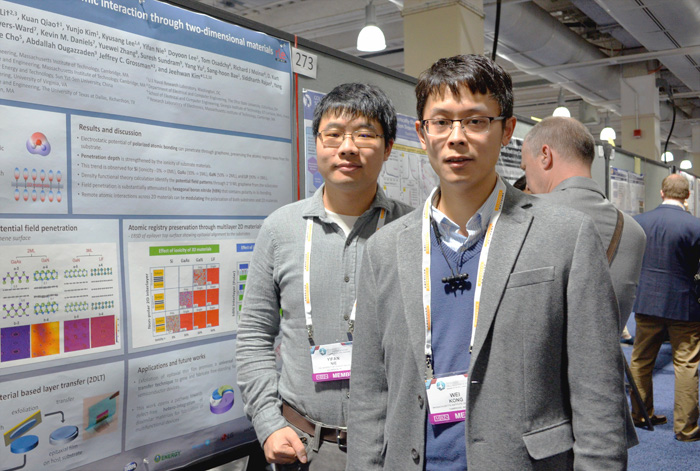Researcher’s Atomic-Level Work Makes Material Difference in MIT Study
By: | Dec. 6, 2018

Yifan Nie (left), with Dr. Wei Kong of the Massachusetts Institute of Technology, has worked on computer simulations that show how two-dimensional materials perform at the atomic level. Nie’s expertise played a vital role for an MIT team developing an alternative to silicon.
Whether it’s a Broadway play or scientific theater, sometimes it’s the supporting cast who make for a successful production.
One clear example of the latter is Yifan Nie, a University of Texas at Dallas graduate student in materials science and engineering who will earn his PhD next week.
Nie’s research has focused on developing complex computer simulations that model the physics and behavior of two-dimensional materials at the atomic level. Working with faculty mentor Dr. Kyeongjae Cho, Nie has published several scientific papers and presented his research at multiple professional conferences.
He received plaudits recently for his supporting role in work led by researchers at the Massachusetts Institute of Technology.
“This is an example of the quality of research UTD students are performing for their doctoral research and how the research community is seeking them out for their excellent qualifications.”
Dr. Kyeongjae Cho, professor of materials science and engineering
“This is an example of the quality of research UTD students are performing for their doctoral research and how the research community is seeking them out for their excellent qualifications,” said Cho, professor of materials science and engineering in the Erik Jonsson School of Engineering and Computer Science.
The MIT scientists were seeking an alternative to silicon for the production of low-cost, high-performance semiconductors for devices like flexible solar cells and wearable technology. The researchers fabricated ultrathin, flexible semiconducting films made from a host of exotic materials, in the hopes of finding an ideal alternative to silicon.
Before they could publish their results, however, they needed additional support for their theories of how the materials should perform on the atomic level. One of the scientists had heard Nie present a talk about his simulations at a scientific conference and reached out to him for assistance.
Commencement Coverage
University Gets Ready for Record Fall Finale
International Peer Advocate Helps Others Navigate the World of UTD
New University Resource Helps Students Complete Degrees on Time
Nie used his expertise in kinetic Monte Carlo computer simulations to provide a detailed understanding of the theory and guidance that enabled the MIT team to successfully grow their crystals.
The research was published in the journal Nature Materials, with Nie as a co-author.
“I am fortunate I could help,” Nie said. “I happen to have the specific skill set that they needed.”
“MIT has some of the best scientists and greatest resources in the world,” Nie said. “But no university has everything. If researchers need something, and it’s not contained at their institution, they often look elsewhere. This time they found what they needed at UT Dallas.”
Nie will work at Lawrence Berkeley National Lab in Berkeley, California, after graduation.
Media Contact: The Office of Media Relations, UT Dallas, (972) 883-2155, newscenter@utdallas.edu.





